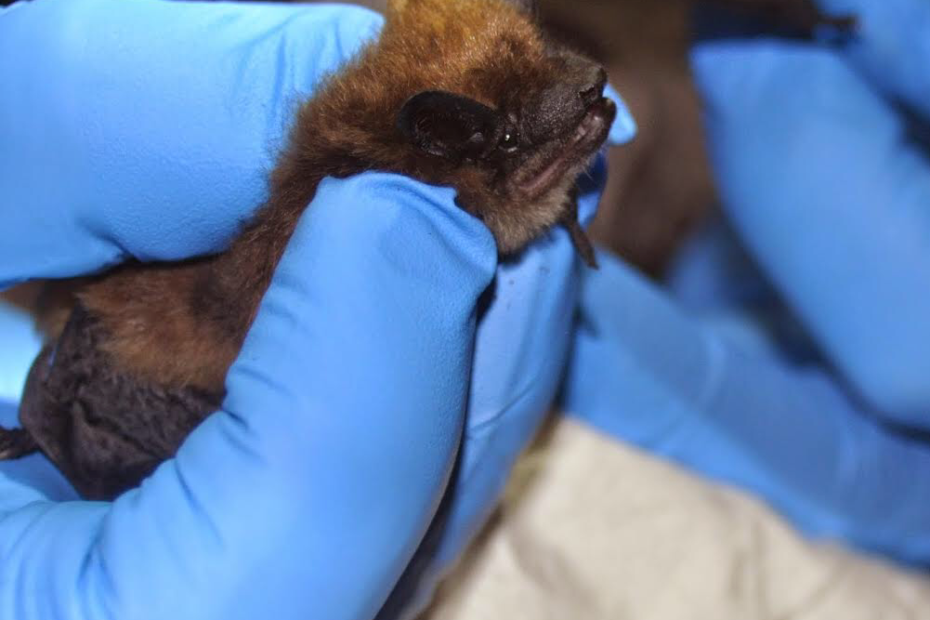I have realized that in my posts I refer to a variety of different bat species. While the number of species found in this area is not particularly large, it can still be confusing. I thought it would be fun to give some brief descriptions of the common bats in this area (plus show off some of my better bat photographs). All information on bat descriptions was obtained from Mammals of North America by Fiona A. Reid (which is a great resource if you are interested in mammal identification and ecology).
California Myotis (Myotis californicus)
This is one of the smallest species found in this area. They are generally reddish brown in color, with dark brown ears and wing membranes. In addition, they are identified in this area by their relatively small feet and the presence of a keel on the calcar (a small flap of skin on the ankle of the bat).
Yuma Myotis (Myotis yumanensis) / Little Brown Myotis (Myotis lucifugus)
In the redwoods, these two species are almost morphologically identical, small, brown bats without a keel on the calcar. Yuma myotis tend to have whiter fur on the belly, though it is difficult to use color as an identifying feature. Little Brown Myotis are slightly larger than Yuma Myotis. Both are commonly found around water and are often found inhabiting human dwellings. On the east coast, Little Brown Myotis are facing large population losses due to white-nose syndrome, though western populations have not yet been affected by the fungus. Information on white-nose syndrome can be found here: www.whitenosesyndrome.org
Silver Haired Bats (Lasionycteris noctivagans)
The distinct silver haired bats of one of the tree bats found in this area. Instead of roosting in large colonies in houses or in caves, these bats rely on tree snags and crevices for roosting and migrate each season. They have a thick black fur tipped with silver, and fur extending down the uropatagium (skin flap between the legs of bats).
Big Brown Bats (Eptesicus fuscus)
One of my favorite bats, Big Brown bats are fairly large and brown, with long, dog-like muzzles. On the east coast, this species has also been affected by white nose syndrome, though not as drastically as the Little Brown Myotis. They are common in manmade structures in the east, and roost primarily in trees and cavities in the west. In addition, they will become awake in response to temperature change, and can be spotted out and about even in mid-winter.
Western Red Bat (Lasiurus blossevillii)
Another gorgeous tree bat, the western red bat is about the same size as a silver haired bat, with thick red and white fur. The uropatagium is also extensively furred, and can be pulled up over their body like a blanket. These bats remind me of little lions, with a bush of red hair on their head and beautiful red and black patterning on their wings. They most likely roost in deciduous trees, particularly along riparian areas such as streams.
Hoary Bat (Lasiurus cinereus)
The most striking and kingly of North American bats, and the largest at almost 30g. They have distinct silver tipped fur and a yellowish-white ruff around their neck. Like the silver haired bat and red bat, they have a furred uropatagium which helps keep them warm in colder temperatures. These bats are migratory, and are facing threats from wind energy.
The next few bats I don’t have good example pictures of, but are occasionally captured in the redwood forests.
Fringed Bat (Myotis thysanodes)
A myotis bat with ears that extend past the tip of the nose if laid forward. Most distinctly is the fringe of hairs along the edge of the tail membrane, hence the name.
Long-legged Myotis (Myotis volans)
Another long earred myotis, they have long forearms and reddish brown to blondish fur. The underside of the wings closest to the body are slightly furred (i.e. furry armpits) and they have a keeled calcar. We don’t commonly catch this species, though this past summer we caught a lactating female, indicating some reproductive individuals in the area.
Hope that helps clear up some questions about the bat species in the area. This is not a comprehensive coverage of bats of California, just the species we most commonly catch in our nets. If you are looking for more information on bat species in California and throughout North America, check out Bat Conservation International’s species profiles, which can be found here: Species Profiles








This is nicely written and provides good insight into the different kinds of bats. I never knew how different they are.
This is excellent. Really nice. I have a suggestion (don’t I always have a “suggestion?”) ((how annoying is that??))
Anyway … I suggest copying the URL of your blog post and then simply pasting it into the update boxes on LinkedIn, Facebook and G+
You probably already do this for LinkedIn and Facebook. You would be surprised at how many views your G+ profile also gets.
Dad